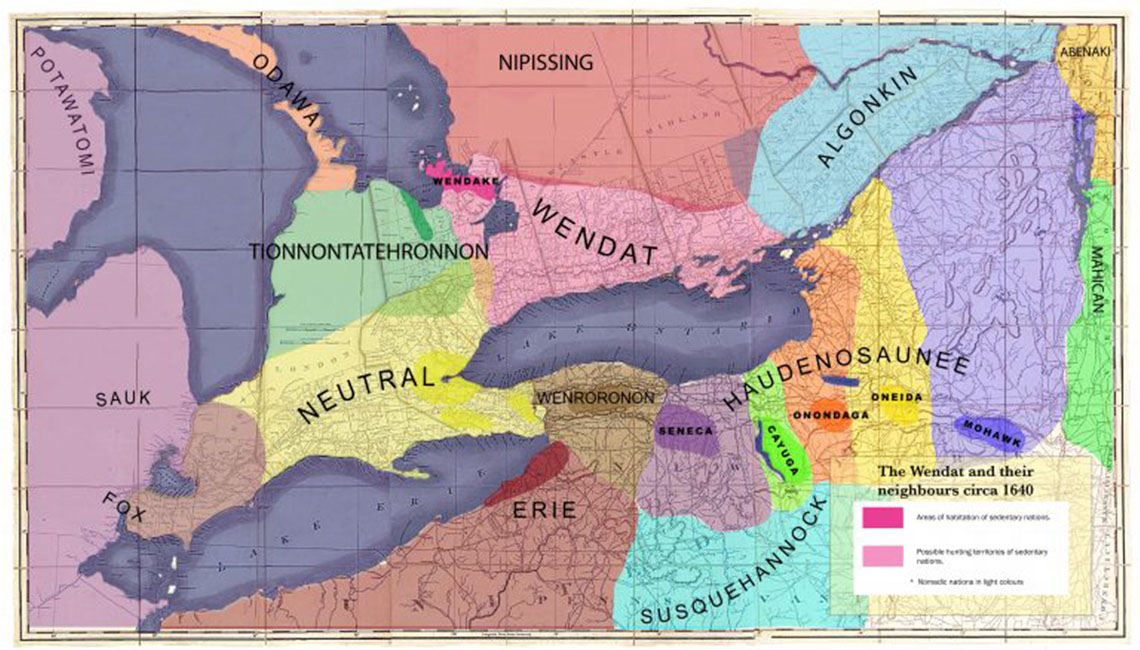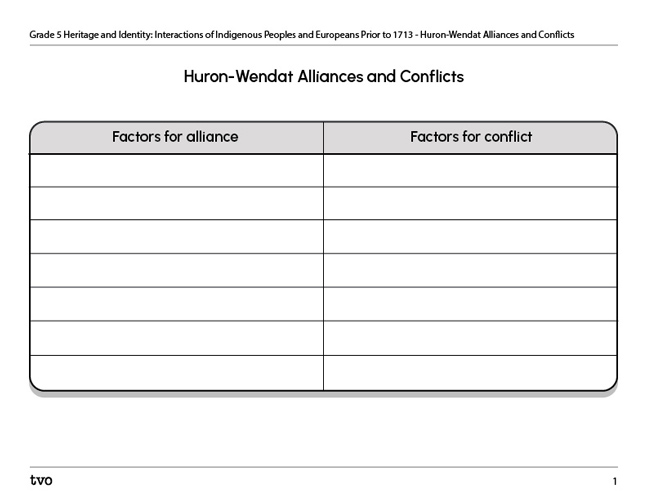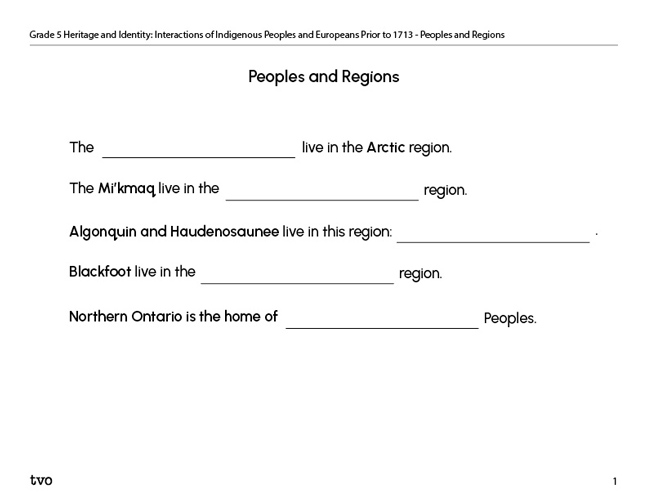Minds On
A Huron-Wendat village
Explore the following Huron-Wendat village.

Inspired by the multi-family longhouses found in historical Huron-Wendat villages, ideally located near land suitable for farming and close to water access.
Based on the illustration:
- What structures, objects, and practices (elements of daily life) are present?
- What is the purpose of each of these elements?
- What do you notice about where the community is located and how it is organized?
Throughout this learning activity, you can record your ideas and responses on the computer, orally, or on paper.
Action
Indigenous Peoples and their traditional territories
First Nation and Inuit communities interacted with neighbouring communities through trade, co-operation, and sometimes conflict.
Before European contact, there were no formal borders that outlined provinces or countries on Turtle Island. However, there were guidelines as to how and where people travelled, hunted, and lived, so that they would not interfere with other communities.
Just like the Huron-Wendat, Indigenous Peoples lived in specific regions across Turtle Island. These regions were and remain their traditional territories. The following are some examples of the nations that had territories in one or more of these regions.
Please note that this list does not include every nation in these regions but provides examples of what nations lived in which regions.

Physiographic regions of Turtle Island
Press each geographic area to learn about the physiographic region(s) and some Indigenous nations from that region.
Physiographic region: St. Lawrence Lowlands
Indigenous Peoples: Abenaki, Algonquin, Haudenosaunee (Cayuga, Mohawk, Oneida, Onondaga and Seneca), Huron Wendat, Odawa, Ojibwe, Potawatomi
Physiographic regions: Hudson Bay Lowlands, Canadian Shield
Indigenous Peoples: Cree and Ojibwe
Physiographic regions: Appalachian, Canadian Shield
Indigenous Peoples: Beothuk, Innu, Inuit, Maliseet, Mi’kmaq, Passamaquoddy, Wolastoqiyik
Physiographic regions: Interior Plains, Western Cordillera, Canadian Shield
Indigenous Peoples: Assiniboine, Blackfoot, Nakoda, Saulteaux
Physiographic region: Western Cordillera
Indigenous Peoples: Haida, Haisla, Heiltsuk/Owik’ala, Gixtsan Kwakwaka’wakw, Nuu-chah-nulth, Salish, Squamish and Tsimshian
Physiographic region: Arctic
Indigenous Peoples: Inuit and Dene
Complete the Peoples and Regions fill-in-the blank activity in your notebook or use the following fillable and printable document. You may also use a method of your choice.
The Huron-Wendat
The Huron-Wendat were a confederacy initially made of four nations. A confederacy is a group of people joined for a common purpose.
Huron-Wendat members and territory
The nations of the Huron-Wendat Confederacy included: the Attignawantan (or Bear people), the Attigneenongnahac, and later, the Arendarhonon and the Tahontaenrat.
Like the Haudenosaunee, Huron-Wendat societies are matriarchal. Matriarchal societies trace a person’s descent through the mother’s side of the family. Members of the community belonged to matrilineal (the mother’s line) clans, which outlined the roles and responsibilities of each member of the community. These clans included Wolf, Turtle, Beaver, Bear, Deer, Fox, Loon, or Hawk.
Traditional crops of the Huron-Wendat were maize, beans, and squash. When crops and forests in a particular region were exhausted, the Huron-Wendat relocated within their traditional territory, as outlined in the following image, to plant new crops and build new longhouses. This occurred approximately every 10 to 15 years.
As we work towards Truth and Reconciliation, information about lands and territories is constantly being updated. This map was created using information available as of July 2021 from the First Nations of Simcoe County.
Please note spelling difference – Algonkian vs Algonquin. Algonquin is the official spelling:

Map disclaimer: As we work towards Truth and Reconciliation, information about lands and territories is constantly being updated. This map was accessed through First Nations of Simcoe County in June 2024.
Huron-Wendat social roles
Within Huron-Wendat society, everyone fulfilled different roles and held different responsibilities. Press the following tabs to explore the various social roles of the Huron-Wendat.
Check your understanding
Reflect on the information on Huron-Wendat society and answer the following true or false questions.
Huron-Wendat alliances and conflicts
Like many early societies, Indigenous Peoples in Canada formed alliances and worked together; they also found themselves in conflict over resources and territory.
The Huron-Wendat traded and maintained political relations with the Odawa, Algonquin, Petun, and others. They traded beans, corn, and cord for copper, seashells, and tobacco. Beyond trade, good relations meant access to waterways that connected their territories and treaties.
Algonquin
Algonquin First Nations live in a large region within both Ontario and Quebec near the Ottawa River. Algonquin society differed from the Huron-Wendat in that they were patrilineal (descent was followed through the father’s side of the family). They traveled by birch bark canoes and housing included longhouses and wigwams (domed dwellings that were smaller). Wigwams were easy to assemble and reassemble as communities travelled to hunting grounds. Community leaders included clan leaders and elders.
Student Tips
Did you know?
The Algonquin nation and traditional territory should not be confused with the Algonquin language, which was widely spoken and was used in Turtle Island lands far outside Algonquin territory.
As we work towards Truth and Reconciliation, information about lands and territories is constantly being updated. This map was created using information available as of July 2021 from Canada's History.
Please note spelling difference – Algonkian vs Algonquin. Algonquin is the official spelling:

Map disclaimer: As we work towards Truth and Reconciliation, information about lands and territories is constantly being updated. This map was accessed through the permission terms of Algonquins of Ontario in June 2024.
Conflict
The Algonquin formed an alliance through trade with the Huron-Wendat that also existed in times of conflict. Competition in trade and territory led to conflict with the Haudenosaunee, especially after the French and British arrived and created alliances with First Nations peoples. The Huron-Wendat were recorded as joining an attack on a Mohawk (member of Haudenosaunee) community in 1609 alongside the Innu and Algonquin.
Eventually, the Algonquin and Huron-Wendat formed an alliance with the French against the Haudenosaunee and the British. The fur trade played a major role in the Huron-Wendat and Algonquin decision to create an alliance with the French. The main item of trade (beaver pelts) was found in abundance in Algonquin and Huron-Wendat territory.
In exchange for military support by the French, the Huron-Wendat opened their communities to missionaries in 1615 and later Jesuits in the 1620s. Missionaries and Jesuits were sent to Turtle Island by the Catholic Church to convert Indigenous Peoples to Christianity, sometimes by force.

This period laid the foundation for future treaties, as Samuel de Champlain joined with Huron-Wendat forces in conflict with the Haudenosaunee. By the 1630s, the Huron-Wendat and its trading partners became the greatest supplier of furs and beaver pelts for the French. The Huron-Wendat and Haudenosaunee fought a series of conflicts in the 1630s-40s that resulted in the loss of many people.
New diseases
Alongside conflict with other nations, a series of epidemics (rapidly spreading diseases like smallpox) played an even greater role in a loss of the Huron-Wendat population.
Press ‘Smallpox’ to access information about early contact smallpox epidemics.
Smallpox was a very deadly virus that European explorers and settlers brought with them to Turtle Island. Already present in Asia, Africa, and Europe for thousands of years, smallpox was one of humanity’s oldest and deadliest natural foes. The Indigenous Peoples of Turtle Island had never been exposed to smallpox before European contact and had no natural immunity like the Europeans. Smallpox was so deadly and spread so quickly to the Indigenous Peoples that it was common for European explorers to find entire uncontacted villages had already been killed by the disease even before their arrival. Worldwide vaccination in the 1960s and 1970s helped to completely eliminate natural smallpox by 1980.
The Huron-Wendat and their allies had lost a great part of their community members to smallpox, and the Haudenosaunee took the opportunity to attempt to overtake the survivors. In 1646, the Algonquin were forced to relocate. By 1649, the Huron-Wendat were defeated by the Haudenosaunee, as were the Petun. The Haudenosaunee sometimes followed a practice of taking captives in battle and later adopting them into their own communities. The result was the dispersal of some Huron-Wendat peoples to the west, while several thousand joined the Haudenosaunee among the Seneca Nation.
Review
Now, let's consider the following questions to review what we have just learned:

- How did the natural environment affect the items that were traded between First Nations peoples?
-
Press Hint to access prompts for answering the question.
Some trade items needed to be grown and some needed to be made by people. Also consider the role of waterways in trade and alliances. - How did the introduction of smallpox affect the relationship between the Huron-Wendat and the Haudenosaunee?
Use a method of your choice to record your thoughts.
Consolidation
Alliances and conflicts
In the Action section, we have considered the factors that led the Huron-Wendat to form alliances with the Algonquin Nation and engage in conflict with the Haudenosaunee Nation.
Using what you have learned, complete the following organizer, Huron-Wendat Alliances and Conflicts, in your notebook or use the following fillable and printable document. If you like, you can record your thoughts using another method of your choice.

Press the Activity button to access the Huron-Wendat Alliances and Conflicts organizer.
Activity(Opens in a new tab)Think about your learning
Now let's consider the following questions to help us think about what we have just learned:
- For these Nations, what was the factor that contributed the most to conflict?
- For these Nations, what was the factor that contributed the most to their ability to form alliances?
Use information that you learned in this lesson to help support your answer. Record your answer using a method of your choice.
Reflection
As you read through these descriptions, which sentence best describes how you are feeling about your understanding of this learning activity? Press the button that is beside this sentence.
I feel...
Now, record your ideas using a voice recorder, speech-to-text, or writing tool.
